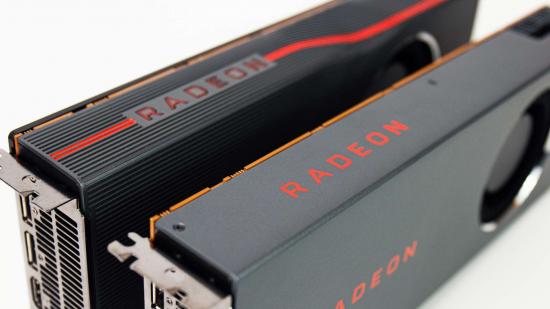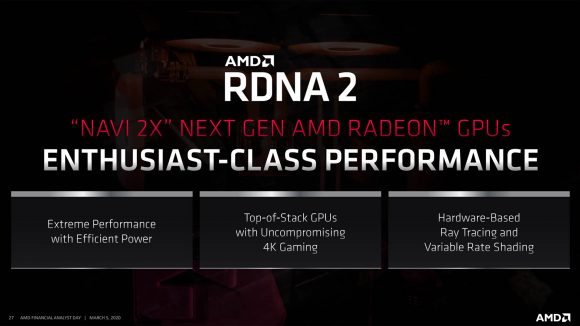AMD’s Navi 2X graphics card lineup won’t stop at ‘Big Navi’. Over at AMD’s Financial Analyst Day, the company confirmed that a full top-to-bottom lineup of graphics cards on the RDNA 2 architecture, some of which will arrive by the end of 2020, including mid-range and entry-level fare alongside an “uncompromising 4K” GPU.
AMD rounded up its top executives for a extensive three-and-a-half hour long presentation regarding the future of AMD Ryzen, EPYC, and Radeon yesterday. The event marked the official confirmation of a few key things, including: Navi 2X and Navi 3X, Zen 4 on 5nm, and the CDNA architecture. For us gamers, however, it’s the promise of a full stack of RDNA 2 graphics cards, from 1080p to 4K chips, that has us counting down the days until Q4.
So here’s what we know about RDNA 2 so far. Set to launch within graphics cards by the codename of Navi 2X, RDNA 2 chips will feature “extreme performance with efficient power,” hardware-based ray tracing, and variable rate shading. It’s the same architecture set to power the Xbox Series X by ‘holiday 2020’, the specs of which were announced by Microsoft last month.
“What’s next of course is the big question,” Rick Bergman, EVP of computing and graphics at AMD, says. “Of course, that will be our Navi 2X family of products. We’ll introduce those products at the end of this year. But clearly we’re stepping up and we’re targeting the enthusiast-class performance as well, which means we have to have great performance at 4K resolutions.
“That means uncompromised performance for fluid play, and, of course, we just have to have stunning visuals as well. We’e talked about the importance of ray tracing to show the shadows and reflections and to be able to game at a very fluid consistent rate. So it’ll have additional features such as variable rate shading as well to give you that performance uplift so critical in this segment of the market.”
Bergman also hints at a staggered launch for RDNA 2 graphics cards. “And we’ll take that 2X stack across, over time, the entire top-to-bottom lineup for graphics.” Our best guess would have the heavily-rumoured ‘Big Navi’ GPU shoring up the enthusiast segment for AMD first – Dr. Lisa Su assured us “high-end Navi” will launch in 2020 – with a full compliment of entry- to mid-range graphics cards to follow at a later date.
First generation RDNA is currently available within the RX 5500, 5600, and 5700 series. These graphics cards also had a staggered release, with the RX 5700 series launching first in July, 2019, and the RX 5600 XT in January, 2020.
What’s noticeably missing from AMD’s presentation slides is reference to ‘7nm+’. The company is instead touting a second 7nm generation, following Zen 2 and RDNA, that, according to a report by Anandtech, leaves the door open to two potential TSMC nodes: N7P (non-EUV) and N7+ (EUV). The company is yet to confirm which node it will be using.
Yet this has done little to hinder its aspirations for RDNA 2. “Our plan, our target, is to drive another 50%,” David Wang, SVP Radeon Technologies Group, says in relation to performance per watt on RDNA 2. That would make for a mighty improvement, and one which would likely come from architectural changes rather than relying heavily on process node.
With AMD bringing Zen expertise to the Radeon team to bolster efficiency, it’s no surprise that the company is setting expectations high. After all, it will have to compete with Nvidia for 4K GPU dominance. With a late 2020 release window, Nvidia may even beat AMD RDNA 2 graphics cards to market with its own next-gen kit (rumoured to be called Nvidia Ampere). But will it beat the red team on price?

